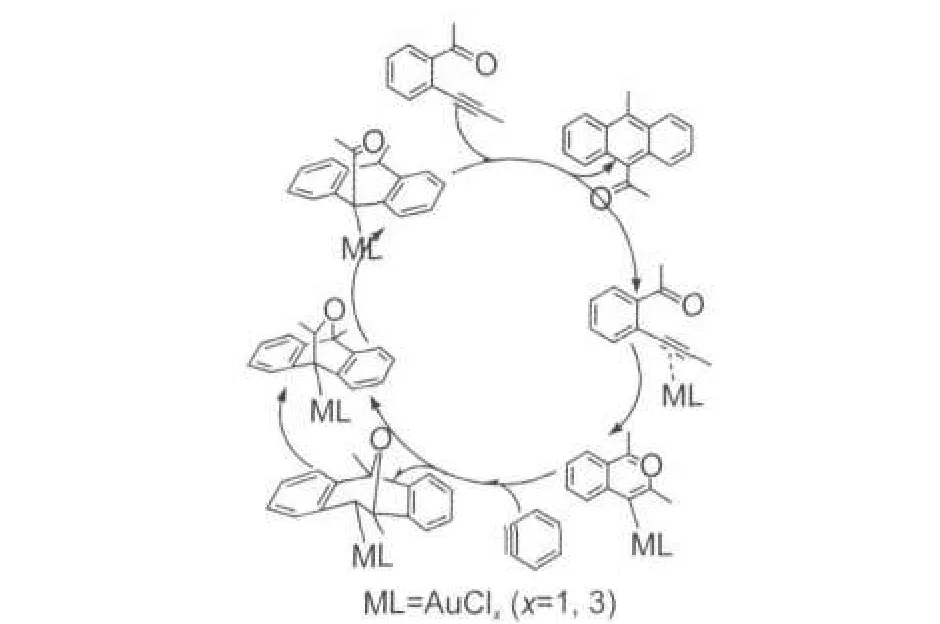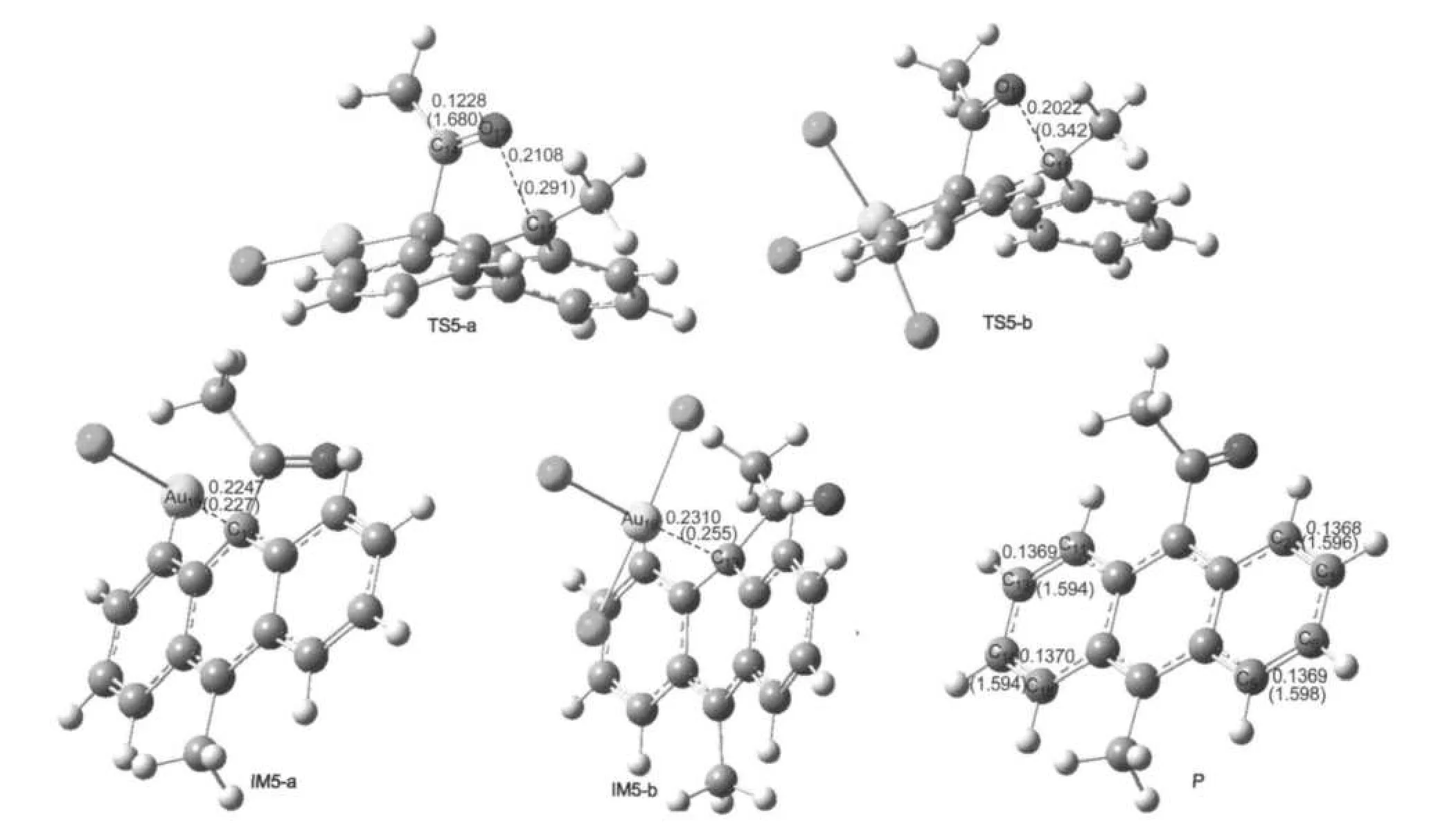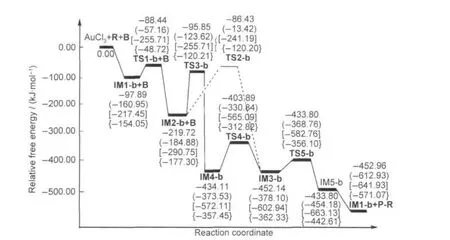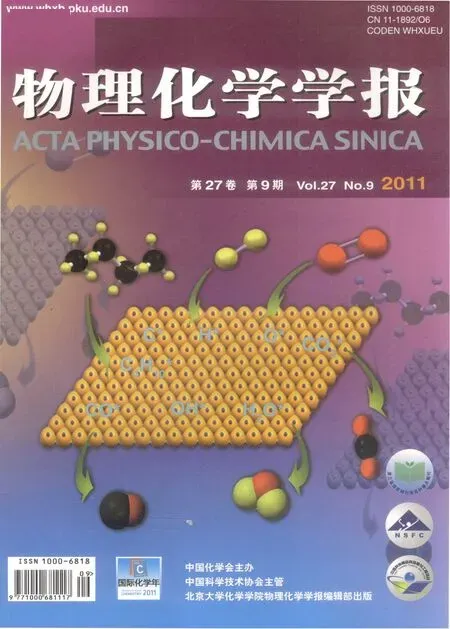AuClx(x=1,3)催化2-炔丙基苯酮与苯炔环化反应机理
朱元强 郭建春 叶仲斌
(1油气藏地质及开发工程国家重点实验室,西南石油大学化学化工学院,成都610500; 2西南石油大学石油工程学院,成都610500)
AuClx(x=1,3)催化2-炔丙基苯酮与苯炔环化反应机理
朱元强1,*郭建春2叶仲斌1
(1油气藏地质及开发工程国家重点实验室,西南石油大学化学化工学院,成都610500;2西南石油大学石油工程学院,成都610500)
对金属元素Au采用LanL2DZ基组,对非金属元素C,H,O,Cl采用6-31G*和6-311++G**基组,用密度泛函理论的B3LYP、B3PW91、UB3LYP方法和二阶微扰理论MP2方法研究了不同氧化态的金催化剂催化2-炔丙基苯酮与苯炔环化反应的机理.结果表明:在AuCl和AuCl3的作用下,反应均能通过[4+2]和[3+2]途径生成产物.但在AuCl催化下,[4+2]反应途径比[3+2]反应途径具有更低的活化自由能,反应主要通过[4+2]途径进行;而在AuCl3催化下,[4+2]反应途径与[3+2]反应途径的活化自由能相近,反应通过两条途径竞争生成产物.比较AuCl和AuCl3的催化效果发现,不同氧化态的金催化剂改变了反应的机理,该反应的活化自由能在AuCl作用下比在AuCl3作用下低11.18 kJ·mol-1.对于该反应,AuCl表现出了更好的催化活性.这些计算结果和实验现象相吻合.
金催化剂;密度泛函理论;反应机理;[4+2]环化途径;[3+2]环化途径
1 Introduction
The long-standing notion of gold as an unreactive coinage and expensive metal limited its utility,although a variety of transition metal-catalyzed inter-and intra-molecular cycloaddition reactions of alkynes and alkenes have been reported.1-3But recently,the application of gold catalysts in organic synthesis has received much attention because of its special reactivity and selectivity in transformations such as inter-and intra-molecular cycloaddition reactions,cyclizations,cycloisomerizations,and rearrangements.4-9Compounds of gold(I)as well as gold(III)are powerful catalysts.Complexes with both gold oxidation states I and III have been considered as active species.10-12The reduction of gold(III)compounds in the reaction is rapid due to its high oxidation potential,but the reduction of the low oxidation state gold(I)is relatively slow.13The rapid reduction is similar to some late transition metal-catalyzed reactions.14,15Thus,the question arises whether both gold oxidation states I and III as catalysts are potentially active.16In many experiments,both gold(I)and gold(III)catalysts have emerged as powerful tools of constructing highly complex molecules through using alkynes as two-carbon assembling units.17-20Among alkynes,benzyne is an important substrate and many investigations on its reaction have been undertaken in synthetic organic chemistry.21-23Cycloadditions with benzyne are one of the most important methods for the construction of polyaromatic compounds.24-28Recently,Asao and his coworkers29have reported that gold-catalyzed[4+2]benzannulations between o-alkynyl(oxo)benzenes and alkynes proceeded smoothly in both inter-and intra-molecular to afford naphthalene compounds with good to high yields.However,Asao and Sato30are the first researchers to report the AuCl-catalyzed formal[4+2]benzannulation between o-alkynyl(oxo)benzenes and benzenediazonium 2-carboxylate.In their studies,gold(I)catalyst gives a higher yield than other catalysts.It is believed that the reaction proceeds through the formation of a benzopyrylium type intermediate,followed by the Diels-Alder addition of alkynes.They proposed that this reaction proceeded via a formal[4+2]mechanism.In Straubʹs31study of the mechanisms of gold-catalyzed benzannulation reaction between o-alkynyl(oxo)benzenes and alkynes with a modeled reaction system,he confirmed theoretically and experimentally a[3+2]reaction pathway instead of determining the formal[4+2]process.Both Asao and Straub investigated the influence of the gold oxidations states on the overall reaction barrier,but the results they got indicated that the influence was inconspicuous.
The inconsistency of their results prompts us to investigate the mechanism of the AuClx(x=1,3)-catalyzed benzannulation reaction between o-alkynyl(oxo)benzenes and benzyne.In this study,we performed calculations by using the density functional theory(DFT),the second-order Møller-Plesset perturbation theory(MP2),and the natural bond orbital(NBO)analysis to study the title reaction.The main challenge is to predict the influence of the gold oxidation states on the overall reaction barrier and the detailed reaction mechanism.
2 Computational methodology
Reaction pathways of both the proposed AuCl and AuCl3catalyzed reactions of 2-propynyl-hypnone with benzyne were investigated in this work.The 2-propynyl-hypnone and benzyne were used as simplified quantum-chemical model substrates. The reaction processes between benzyne and 2-propynyl-hypnone were shown in Fig.1.It has been proven that B3PW91 functional in combination with the LanL2DZ pseudopotential can obtain good quality geometries,interaction energies,and vibrational frequencies.32-36Therefore,for the modeled reaction,we used the B3PW91,37B3LYP,33,38UB3LYP functional with the LanL2DZ effective core potential39-41and basis set for gold,and 6-31G*basis set for C,H,O,Cl to optimize the stationary points.For each stationary point,a frequency calculation was carried out at the same level to obtain its thermal corrections to Gibbs free energy and to verify whether it is a minimum or a transition state.The intrinsic reaction coordinate (IRC)calculations42,43were also performed to further verify the connection between minima and transition states at the B3PW91/(Au:LanL2DZ;C,H,O,Cl:6-31G*)level.To get more credible energy information,single point energy calculations were carried out by using the B3PW91,B3LYP, UB3LYP,MP244-47methods combined with the LanL2DZ effective core potential and basis set for gold,and 6-311++G**basis set for C,H,O,Cl based on the optimized geometries. Moreover,the bondsʹindices of stationary points were analyzed by the NBO theory48to further confirm the breaking and forming of bonds.All calculations were carried out with the Gaussian 03 program49under the conditions of 298.15 K and 101325 Pa.
3 Results and discussion

Fig.1 Reaction processes between 2-propynyl-hypnone and benzyne catalyzed byAuCl andAuCl3

Fig.2 Optimized geometry parameters(without brackets,bond length in nm)and the calculated Wiberg bond indices(in parenthesis)for the coupling of the catalysts with the reactant R at the B3PW91/(Au:LanL2DZ;C,H,O,Cl:6-31G*)level
The geometries optimized with the B3PW91,B3LYP,and UB3LYP methods are structurally similar.As a result,only the corresponding optimized structures,atom labels,important bond lengths,and Wiberg bond indices of stationary points calculated by the B3PW91 method were depicted in Figs.2-5. The reaction between 2-propynyl-hypnone and benzyne catalyzed by AuCl and AuCl3involves three processes.The first process is the coupling of the catalysts with the reactant R to form complexes IM2-a and IM2-b.For the sake of clear expressions,all structures terminally named by-a(such as IM2-a)refer to the reaction catalyzed by AuCl and all structures terminally named by-b(such as IM2-b)refer to the reaction catalyzed by AuCl3.The second process is the[4+2]or[3+ 2]cycloaddition to afford the intermediates IM3-a and IM3-b. The third process is the opening of the pyran ring and the detachment of AuCl and AuCl3to yield the polyaromatic compound P.The relative free energies and the potential energy profiles are presented in Figs.6,7.The calculated results of B3PW91,B3LYP,UB3LYP,and MP2 methods present the same tendency of the whole reaction.In the following sections, we will discuss the reaction mechanisms based merely on the relative free energies calculated by the MP2 method.
3.1 The coupling of the catalysts with the reactant R
As shown in Figs.2,6,7,the first process involves two steps,namely the coupling of the catalyst AuCl or AuCl3with the substrate R and the formation of the pyran ring.For the substrate R,the C13≡C14bond presents the nature of a triplet bond with the Wiberg bond index of 2.696.In the first step,the catalyst AuClor AuCl3attacks the triplet bond C13≡C14in R and form the intermediate IM1-a or IM1-b.The nucleophilic attacks the carbonyl oxygen of IM1-a and IM1-b at the terminal alkynyl carbon C13and forms the gold coordination compound. The resulting intermediates are IM2-a and IM2-b.They can be regarded as mesomeric structures of an oxonianaphthalene aurate.The complexes of AuCl with alkynes have been structurally characterized.35Comparing with the C13≡C14triplet bond in R in Fig.2,one can see that those in IM1-a and IM1-b are weakened with longer bond lengths of 0.1250 and 0.1241 nm and smaller Wiberg bond indices of 2.345 and 2.346,respectively.Moreover,the bonds between Au and C13,C14atoms are partly formed with the Wiberg bond indices in the range of 0.145 to 0.330.As shown in Figs.6,7,the coupling interaction between catalysts and R makes the free energy of the reaction system greatly decreased by 160.58 and 217.45 kJ·mol-1for AuCl and AuCl3,respectively.Although both AuCl and AuCl3can stabilize the reaction system,AuCl makes the reaction system more stable.In the second step,the reaction needs to surmount the free energy barrier of transition states TS1-a and TS1-b.An analysis of the vibrational modes indicates that both TS1-a and TS1-b have only one imaginary frequency of 283i and 342i cm-1which corresponds to the stretching of the C14O12bond,respectively.The complex involving a pyran ring is given after the formation of the C14O12bond.In TS1-a and TS1-b,the Wiberg bond indices of the C14O12bond increase to 0.188 and 0.219,respectively.With the reaction undergoing, the Wiberg bond indices of the C14O12bond further increase to 0.992 and 0.991 in IM2-a and IM2-b,respectively.These changes indicate that both IM2-a and IM2-b containing a pyran ring are formed.In terms of the relative free energy,the relative free energy of IM2-b is lower than that of IM2-a by 73.76 kJ·mol-1.Accordingly,AuCl3indicates a stronger interaction with 2-propynyl-hypnone substrate than AuCl,although both IM2-a and IM2-b are very stable.As can be seen from Figs.6,7,the formation of IM2-a needs to surmount a higher free energy barrier than that of the formation of IM2-b by 18.11 kJ·mol-1.The difference of the free energy barrier and the energies of stability indicates that the catalyst AuCl3,which makes the reaction system extraordinary stable,is more effective in this step thanAuCl.

Fig.3 Optimized geometry parameters(without brackets,bond length in nm)and the calculated Wiberg bond indices(in parenthesis)for the[4+2]cycloaddition process at the B3PW91/(Au:LanL2DZ;C,H,O,Cl:6-31G*)level

Fig.4 Optimized geometry parameters(without brackets,bond length in nm)and the calculated Wiberg bond indices(in parenthesis)for the[3+2]cycloaddition process at the B3PW91/(Au:LanL2DZ;C,H,O,Cl:6-31G*)level

Fig.5 Optimized geometry parameters(without brackets,bond length in nm)and the calculated Wiberg bond indices(in parenthesis)for the catalysts detaching from the product at the B3PW91/(Au:LanL2DZ;C,H,O,Cl:6-31G*)level
3.2 Cycloaddition of benzyne to complexes IM2
3.2.1 The[4+2]cycloaddition process
As shown in Figs.3,6,7,the stable intermediates IM3-a and IM3-b are afforded for catalysts AuCl and AuCl3through the [4+2]benzannulation channels in this process.In the[4+2] benzannulation pathway,the formation of intermediates IM3-a and IM3-b needs to surmount transition states TS2-a and TS2-b with the synchronous attacking of the C30,C25atoms in benzyne with the C11,C13atoms in IM2-a and IM2-b.The Wiberg bond indices of the C13C25and C11C30bonds are 0.320 and 0.554 in TS2-a and 0.340 and 0.550 in TS2-b,respectively.An analysis of the vibrational modes indicates that both TS2-a and TS2-b have only one imaginary frequency of 286i and 342i cm-1corresponding to the stretching of the two bonds, respectively.These Wiberg bond indices are greater than those in IM2-a and IM2-b,which shows the formation of the two bonds.With the reaction undergoing,the C13C25and C11C30bonds becomes stronger and stronger with the Wiberg bond indices of 0.938 and 0.985 in IM3-a and 0.915 and 0.977 in IM3-b,respectively.Finally the formal[4+2]cycloaddition intermediate IM3-a and IM3-b are formed.The energies of stability for IM3-a and IM3-b are 521.67 and 602.94 kJ·mol-1,respectively.Accordingly,IM3-b is more stable than IM3-a, namely,AuCl3showing a strong interaction with substrates. From Figs.6,7,one can see that the formation of IM3-a needs to surmount a free energy barrier of 23.86 kJ·mol-1for AuCl while the formation of IM3-b needs to surmount a free energy barrier of 49.56 kJ·mol-1for AuCl3.The differences of the activation of free energy indicate that AuCl is more effective than AuCl3for the formation of the[4+2]cycloaddition intermediates.The[4+2]benzannulation reaction mechanism is in good agreement with the one proposed experimentally by different groups.29,30
3.2.2 The[3+2]cycloaddition process

Fig.6 Schematic potential energy profile for the title reaction catalyzed byAuCl at the B3PW91/(Au:LanL2DZ;C,H,O,Cl:6-311++G**) (without brackets),the B3LYP/(Au:LanL2DZ;C,H,O,Cl:6-311++G**)(in parenthesis),the MP2/(Au:LanL2DZ;C,H,O,Cl:6-311++G**) (in square brackets),and the UB3LYP/(Au:LanL2DZ;C,H,O,Cl:6-311++G**)(in big brackets)levels

Fig.7 Schematic potential energy profile for the title reaction catalyzed byAuCl3at the B3PW91/(Au:LanL2DZ;C,H,O,Cl:6-311++G**)(without brackets),the B3LYP/(Au:LanL2DZ;C,H,O,Cl:6-311++G**)(in parenthesis),the MP2/(Au:LanL2DZ;C,H,O,Cl:6-311++G**)(in square brackets),and the UB3LYP/(Au:LanL2DZ;C,H,O,Cl:6-311++G**)(in big brackets)levels
In the[3+2]reaction pathway,as shown in Figs.4,6,7,the formation of IM3-a and IM3-b needs to proceed via two steps for the reaction catalyzed by both AuCl and AuCl3.In the first step,the C30and C25atoms in benzyne synchronously attack the C4and C2atoms in IM2-a and IM2-b and afford intermediates IM4-a and IM4-b through transition states TS3-a and TS3-b, respectively.An analysis of the vibrational modes indicates that both TS3-a and TS3-b have only one imaginary frequency of 307i and 400i cm-1,respectively which are corresponding to the stretching of the two bonds.The Wiberg bond indices of the C14C25and C11C30bonds are 0.411 and 0.712 in TS3-a and 0.335 and 0.475 in TS3-b,respectively,showing the forming of the two bonds.After the two bondsʹformation,the intermediates IM4-a and IM4-b are afforded.In IM4-a and IM4-b,the C14C25and C11C30bondsʹWiberg bond indices are greater than 0.9,which indicates their complete formation. In the second step,the C25atom transfers from the C14atom to the C13atom and generates IM3-a and IM3-b through transition states TS4-a and TS4-b.An analysis of the vibrational modes indicates that both TS4-a and TS4-b have only one imaginary frequency of 365i and 316i cm-1,respectively which are corresponding to the stretching of the C14C25and C11C30bonds.For TS4-a,the C14C25bond length is 0.0223 nm longer than that in IM4-a and the Wiberg bond index is 0.377 smaller than that in IM4-a,which shows the break of the C14C25bond.Meanwhile,the C13C25bond shortens from 0.1778 nm in TS4-a to 0.1544 nm in IM3-a,showing the formation of the C13C25bond.After the formation of the C13C25bond, IM3-a is afforded and the[3+2]benzannulation process is completed.The activation free energy of this step is 22.99 kJ· mol-1.That is 135.12 kJ·mol-1lower than that of the first step. The first step is the rate determining step of the[3+2]benzannulation process.Comparatively,the reaction with AuCl3proceeds via a similar reaction mechanism of the reaction as Au-Cl.The rate determining step of the[3+2]benzannulation process is also the first step with an activation free energy for TS3-b of 35.04 kJ·mol-1.For this process,the similar mechanism was proposed by Straub31when he studied the reaction of gold-catalyzed benzannulation between o-alkynyl(oxo)benzenes and alkynes with a modeled reaction system.Instead of determining the formal[4+2]reaction pathway,he confirmed theoretically and experimentally the[3+2]reaction pathway.
In this study,we also determined the[3+2]benzannulation mechanism,which is in good agreement with the results of Straub.31However,apart from the[3+2]benzannulation pathway,we also determined the[4+2]benzannulation pathway. The gold oxidation states influence the overall reaction barrier and change the reaction mechanism.With the gold(I)catalyst, the intermediate IM3-a is formed mainly through the[4+2] benzannulation pathway because of its low activation of free energy of the rate determining step.With the gold(III)catalyst, the intermediate IM3-b is formed through the two competitive [3+2]and[4+2]benzannulation pathways because there is little difference between the activation free energy of the rate determining steps of the two benzannulation pathways.
3.3 The detachment of catalysts from product
With the opening of the pyran ring and the detachment of catalysts AuCl and AuCl3,the product P is yielded.As shown in Fig.5,the O12C11bond distance involving in pyran ring lengthens to 0.2108 and 0.2022 nm and the corresponding Wiberg bond index decreases to 0.291 and 0.342 in TS5-a and TS5-b,respectively.The changes of the two bonds show that the reaction proceeds toward the product.The activation free energies for TS5-a and TS5-b are 32.17 and 20.18 kJ·mol-1,respectively,which shows that the opening of the pyran ring can easily occur.After the reaction surmounting the transition states TS5-a and TS5-b,the intermediate IM5-a and IM5-b are generated.In IM5-a and IM5-b,the C13Au19bond lengths are 0.0175 and 0.0190 nm longer than those in IM3-a and IM3-b,respectively.The corresponding Wiberg bond indices are 0.291 and 0.178 smaller than those in IM3-a and IM3-b,respectively.The long bond distance and the small Wiberg bond indices indicate the weak interaction between the catalyst AuCl or AuCl3and the final product P.Moreover,the formation of IM5-a and IM5-b is strongly exothermic.Therefore,the catalyst AuCl and AuCl3can easily detach from the product and be recycled.
3.4 Analysis of relative free energy
As shown in Figs.6,7,with the catalysts gold(I)AuCl and gold(III)AuCl3,the reaction can occur through both the[4+2] and[3+2]benzannulation pathways to yield the product.Moreover,gold oxidation states influence the overall reaction barrier and change the reaction mechanisms.Both with catalysts gold(I)and gold(III),the rate-determining step of the[4+2] pathway is the formation of the formal[4+2]cycloaddition intermediates IM3-a and IM3-b.The formation of the intermediates IM4-a and IM4-b is the rate determining step of the[3+2] pathway.Using AuCl as catalyst,however,the activation of free energy of the rate-determining step of the[4+2]pathway is 134.25 kJ·mol-1lower than that of the[3+2]pathway.Generally,the product yields mainly through the[4+2]benzannulation pathway.But the activation free energy of the rate determining step of the[4+2]pathway is 14.52 kJ·mol-1higher than that of the[3+2]pathway when the catalyst AuCl3is used.As a result,the reaction occurs through the two competitive[4+2] and[3+2]benzannulation pathways to yield the product.The gold element with oxidation state III has higher negative electron affinity than the gold element with oxidation state I.This can lead to the changes of the electron structure of the benzene ring.The gold oxidation state III catalyst is too tied with the reactant and intermediates to activate the reactant and intermediates.As a result,the reaction occurs through different reaction mechanisms with different activation free energies.These results can demonstrate why the reaction yields more products within shorter time under the same condition when using AuCl as the catalyst.30
4 Conclusions
The AuClx(x=1,3)-catalyzed benzannulation reactions between benzyne and 2-propynyl-hypnone were theoretically investigated with the B3PW91,B3LYP,UB3LYP,and MP2 methods.The calculated results indicate that gold oxidation states influence the overall reaction barrier and change the reaction mechanisms.The gold(I)catalyst AuCl is more effective than the gold(III)catalyst AuCl3.Both with the AuCl and AuCl3,the reaction can proceeds via[4+2]and[3+2]pathways to yield the same product.With the gold(I)catalyst AuCl,the reaction mainly occurs through the[4+2]benzannulation pathway, while the reaction with the gold(III)catalyst AuCl3proceeds via the two competitive[4+2]and[3+2]benzannulation pathways.The calculated results can illustrate why the reaction yields the product in higher yields within shorter time under the same condition when AuCl is used as the catalyst.The detailed mechanism of the reaction should provide useful information for further studies.
(1) Teschner,D.;Borsodi,J.;Wootsch,A.;Révay,Z.;Hävecker,M.; Knop-Gericke,A.;Jackson,S.D.;Schlögl,R.Science 2008, 320,86.
(2) Malcolmson,S.J.;Meek,S.J.;Sattely,E.S.;Schrock,R.R.; Hoveyda,A.H.Nature 2008,456,933.
(3) Saito,S.;Yamamoto,Y.Chem.Rev.2000,100,2901.
(4)Hoffmann-Rader,A.;Krause,N.Org.Biomol.Chem.2005,3, 387.
(5) Hashmi,A.S.K.Angew.Chem.Int.Edit.2005,44,6990.
(6) Hashmi,A.S.K.Gold Bull.2004,37,51.
(7) Cui,D.N.;Zheng,Z.L.;Zhang,C.J.Org.Chem.2009,74, 1426.
(8) Dyker,G.Angew.Chem.Int.Edit.2000,39,4237.
(9) Corma,A.;Serna,P.Science 2006,313,332.
(10)Asao,N.;Nogami,T.;Lee,S.;Yamamoto,Y.J.Am.Chem.Soc. 2003,125,10921.
(11) Nevado,C.;Cárdenas,D.J.;Echavarren,A.M.Chem.Eur.J. 2003,9,2627.
(12) Horino,Y.;Yamamoto,T.;Ueda,K.;Kuroda,S.;Toste,F.D. J.Am.Chem.Soc.2009,131,2809.
(13)Norman,R.O.C.;Parr,W.J.E.;Thomas,C.B.J.Chem.Soc. Perkin Trans.1 1976,18,1983.
(14) Straub,B.F.;Hofmann,P.Angew.Chem.Int.Edit.2001,40, 1288.
(15) Straub,B.F.;Gollub,C.Chem.Eur.J.2004,10,3081.
(16) Dyker,G.;Hildebrandt,D.;Liu,J.;Merz,K.Angew.Chem.Int. Edit.2003,42,4399.
(17) Hashmi,A.S.K.Gold Bull.2004,37,3.
(18) Zhang,L.;Kozmin,S.A.J.Am.Chem.Soc.2005,127,6962.
(19) Gorin,D.J.;Davis,N.R.;Toste,F.D.J.Am.Chem.Soc.2005, 127,11260.
(20) Ma,S.;Yu,S.;Gu,Z.Angew.Chem.Int.Edit.2006,45,200.
(21) Biehl,E.R.;Khanapure,S.P.Accounts Chem.Res.1989,22, 275.
(22) Pellissier,H.;Santelli,M.Tetrahedron 2003,59,701.
(23)Wenk,H.H.;Winkler,M.;Sander,W.Angew.Chem.Int.Edit. 2003,42,502.
(24) Lu,J.;Ho,D.M.;Vogelaar,N.J.;Kraml,C.M.;Pascal,R.A., Jr.J.Am.Chem.Soc.2004,126,11168.
(25) Ikadai,J.;Yoshida,H.;Ohshita,J.;Kunai,A.Chem.Lett.2005, 34,56.
(26) Hayes,M.E.;Shinokubo,H.;Danheiser,R.L.Org.Lett.2005, 7,3917.
(27) Dockendorff,C.;Sahli,S.;Olsen,M.;Milhau,L.;Lautens,M. J.Am.Chem.Soc.2005,127,15028.
(28) Henderson,J.L.;Edwards,A.S.;Greaney,M.F.J.Am.Chem. Soc.2006,128,7426.
(29)Asao,N.;Takahashi,K.;Lee,S.;Kasahara,T.;Yamamoto,Y. J.Am.Chem.Soc.2002,124,12650.
(30) Asao,N.;Sato,K.Org.Lett.2006,8,5361.
(31) Straub,B.F.Chem.Commun.2004,1726.
(32) Koch,W.;Holthausen,M.C.A Chemistʹs Guide to Density Functional Theory,2nd ed.;Wiley-VCH:Weinheim,Germany, 2000.
(33) Becke,A.D.J.Chem.Phys.1993,98,5648.
(34) Tielens,F.;Saeys,M.;Tourwé,E.;Marin,G.B.;Hubin,A.; Geerlings,P.J.Phys.Chem.A 2002,106,1450.
(35) Blajiev,O.;Hubin,A.;Tielens,F.;Geerlings,P.J.Raman Spectrosc.2003,34,295.
(36) Doneux,T.;Tielens,F.;Geerlings,P.;Buess-Herman,C. J.Phys.Chem.A 2006,110,11346.
(37) Perdew,J.P.;Wang,Y.Phys.Rev.B 1992,45,13244.
(38) Lee,C.;Yang,W.;Parr,R.G.Phys.Rev.B 1988,37,785.
(39) Hay,P.J.;Wadt,W.R.J.Chem.Phys.1985,82,299.
(40) Wadt,W.R.;Hay,P.J.J.Chem.Phys.1985,82,284.
(41)Hay,P.J.;Wadt,W.R.J.Chem.Phys.1985,82,270.
(42) Gonzalez,C.;Schlegel,H.B.J.Chem.Phys.1989,90,2154.
(43) Gonzalez,C.;Schlegel,H.B.J.Phys.Chem.1990,94,5523.
(44) Frisch,M.J.;Head-Gordon,M.;Pople,J.A.Chem.Phys.Lett. 1990,166,275.
(45) Frisch,M.J.;Head-Gordon,M.;Pople,J.A.Chem.Phys.Lett. 1990,166,281.
(46) Pople,J.A.;Krishnan,R.;Schlegel,H.B.;Binkley,J.S.Int.J. Quant.Chem.Symp.1979,13,325.
(47) Handy,N.C.;Schaefer,H.F.,III.J.Chem.Phys.1984,81,5031.
(48) Reed,A.E.;Curtiss,L.A.;Weinhold,F.Chem.Rev.1988,88, 899.
(49) Frisch,M.J.;Trucks,G.W.;Schlegel,H.B.;et al.Gaussian 03, RevisionA.01;Gaussian Inc.:Pittsburgh,PA,2003.
May 9,2011;Revised:July 7,2011;Published on Web:July 14,2011.
AuClx(x=1,3)-Catalyzed Benzannulation Mechanisms between 2-Propynyl-hypnone and Benzyne
ZHU Yuan-Qiang1,*GUO Jian-Chun2YE Zhong-Bin1
(1State Key Laboratory of Oil and Gas Reservoir Geology and Exploitation,School of Chemistry and Chemical Engineering, Southwest Petroleum University,Chengdu 610500,P.R.China;2School of Petroleum Engineering,Southwest Petroleum University,Chengdu 610500,P.R.China)
The AuClx(x=1,3)-catalyzed benzannulation mechanisms between benzyne and 2-propynylhypnone were investigated using B3LYP,B3PW91,UB3LYP,and the second-order Møller-Plesset perturbation(MP2)methods with the LanL2DZ basis set for Au and the 6-31G*,6-311++G**basis sets for C,H,O,Cl.For the AuCl or AuCl3catalysts the reaction occurs through both the[4+2]and the[3+2] benzannulation pathways to yield the product.With AuCl,the reaction occurs mainly through the[4+2] reaction pathway because of this pathwayʹs low activation free energy.With AuCl3,the reaction occurs by the[4+2]and the[3+2]reaction pathways.These two pathways are competitive because of their close activation free energies.An analysis of these results indicates that the gold oxidation states change the reaction mechanisms and greatly influence the reaction barriers.The calculated results indicate that the AuCl catalyst is more effective than AuCl3because in the reaction catalyzed by AuCl the activation free energy of the rate determining step is 11.18 kJ·mol-1lower than that of the reaction catalyzed by AuCl3. These results are in good agreement with the experimental observations.
Gold catalyst;Density functional theory;Reaction mechanism;[4+2]Benzannulation; [3+2]Benzannulation
O641
∗Corresponding author.Email:yqzhu@swpu.edu.cn;Tel:+86-28-83037334.
The project was supported by the Scientific Research Fund of Sichuan Provincial Education Department,China(09ZB099).四川省教育厅科研项目(09ZB099)资助

